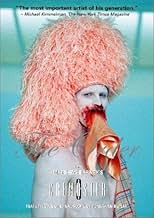IMDb RATING
6.9/10
1.6K
YOUR RATING
The third film of a five-part art-installation epic -- it's part-zombie movie, part-gangster film.The third film of a five-part art-installation epic -- it's part-zombie movie, part-gangster film.The third film of a five-part art-installation epic -- it's part-zombie movie, part-gangster film.
Peter Donald Badalamenti II
- Fionn MacCumhail
- (as Peter D. Badalamenti)
Todd Christian Hunter
- Mason
- (as Todd Hunter)
- Director
- Writer
- All cast & crew
- Production, box office & more at IMDbPro
Featured reviews
Curiosity seekers
seek no more. Pretentious and `arty' could describe it
but I have to say I thought some very good work went into the production design and music. Less such into the "story". It's the top of the Matthew Barney pyramid of art films, culminating in a three hour orgy of celtic mythology, masonic legend, truly retch inducing reverse dental surgery, hardcore punk bands, beautiful models with masonic symbol pasties, double amputee model Aimee Mullins as a catwoman and with clear acrylic prosthetic legs, artist Richard Serra tossing molten vaseline against the walls of the Guggenheim, a sojourn up the elevator shafts of the Chrysler Building, a demolition derby in same's lobby
shall I go on? All the above said, the movie is still truly what it advertised itself to be. The same couldn't be said of many truly awful commercial films, i.e., "Gods and Generals" or "Gigli." You get the broken promises of entertainment and/ or involving historical drama. With C3, you get a chariot race with zombie horses, covered in blankets with the `Cremaster 3' crest emblazoned on them. And don't forget to stop in the museum's gift shop as you leave the theater. Thank you.
This movie is THREE HOURS LONG. I tried, I really tried to understand what the hell was going on, but this epic, incomprehensible art film is nearly impossible to follow, even if you've read the synopsis on the cremaster.net website. There are a lot of visually interesting images, the "car crash" scene and the "dentures" scene being particularly strange and disturbing, but I kept looking at my watch wondering when this awful movie was going to end. However, I can't give it a 3 or a 4, because some of the images, like teeth traveling through intestines, and the leopard lady, are stunning and strange, so I'll be generous and give it 5 out of 10. But I can't recommend it to anyone but the arty elite. When it finished, I got up and said "Thank God that's over!"
Though Matthew Barney doesn't identify himself as a filmmaker per se -- he's a sculptor by training and practice -- his Cremaster Cycle has me convinced that he has a more expansive vision for the possibility of cinema than any new director since Godard grabbed the audience by the hair and pulled us behind the camera with him.
I think part of Barney's resistance to the filmmaker label is that, like the rest of the world, he's been conditioned to believe that movies are only intended to serve a limited set of purposes, namely to act as filmed imitations of ankle-deep novels or plays; that a literal narrative, propelled throughout by actors talking, is the essential element of any movie. This model has been so deeply embedded in all of our psyches that even when a guy like Barney says "f*&^k all that" and defies every conceivable convention, he still feels as though he's doing something which is only nominally a film, even if it is in fact the opposite: a fully realized motion picture experience.
For those who don't know, The Cremaster Cycle is Barney's dreamlike meditation on ... well, I guess it'd be up to each viewer to decide exactly what the topics are, since the movies deliberately make themselves available for subjective interpretaton. Clearly Barney has creation and death on his mind, as well as ritual, architecture and space, symbolism, gender roles, and a Cronenbergian fascination with anatomy.
The movies are gorgeously photographed in settings that could only have been designed by someone with the eye of a true visual artist. In the first half of "3," Barney reimagines the polished interiors of the Chrysler Building as a temple in which the building itself is paradoxically conceived. The second half, slightly more personal, has Barney's alter ego in garish Celtic dress scaling the interior of a sparse Guggenheim Museum, intersecting at its various levels what are presumably various stages of his own artistic preoccupations -- encounters with dancing girls, punk rock, and fellow modern artist Richard Serra, among others.
In the end, what kind of movie is it? It certainly isn't the kind of movie that'll have Joel Silver sweating bullets over the box-office competition. Nor is it likely that more than three or four Academy members will see it, though nominations for cinematography and art direction would be well-deserved. It sure isn't warm and fuzzy: for my money, it might be a little too designed, too calculated. I always prefer chaotic naturalism over studious control. Friedkin over Hitchcock for me. It *is* the kind of movie that the most innovative mainstream filmmakers will talk about ten and twenty years from now when asked what inspired them. Barney's willingness to work entirely with associative imagery, to spell out absolutely nothing, and to let meaning take its first shape in the viewer's imagination, is the kind of catalyst that gives impressionable young minds the notion they can do something they didn't before think possible.
I think part of Barney's resistance to the filmmaker label is that, like the rest of the world, he's been conditioned to believe that movies are only intended to serve a limited set of purposes, namely to act as filmed imitations of ankle-deep novels or plays; that a literal narrative, propelled throughout by actors talking, is the essential element of any movie. This model has been so deeply embedded in all of our psyches that even when a guy like Barney says "f*&^k all that" and defies every conceivable convention, he still feels as though he's doing something which is only nominally a film, even if it is in fact the opposite: a fully realized motion picture experience.
For those who don't know, The Cremaster Cycle is Barney's dreamlike meditation on ... well, I guess it'd be up to each viewer to decide exactly what the topics are, since the movies deliberately make themselves available for subjective interpretaton. Clearly Barney has creation and death on his mind, as well as ritual, architecture and space, symbolism, gender roles, and a Cronenbergian fascination with anatomy.
The movies are gorgeously photographed in settings that could only have been designed by someone with the eye of a true visual artist. In the first half of "3," Barney reimagines the polished interiors of the Chrysler Building as a temple in which the building itself is paradoxically conceived. The second half, slightly more personal, has Barney's alter ego in garish Celtic dress scaling the interior of a sparse Guggenheim Museum, intersecting at its various levels what are presumably various stages of his own artistic preoccupations -- encounters with dancing girls, punk rock, and fellow modern artist Richard Serra, among others.
In the end, what kind of movie is it? It certainly isn't the kind of movie that'll have Joel Silver sweating bullets over the box-office competition. Nor is it likely that more than three or four Academy members will see it, though nominations for cinematography and art direction would be well-deserved. It sure isn't warm and fuzzy: for my money, it might be a little too designed, too calculated. I always prefer chaotic naturalism over studious control. Friedkin over Hitchcock for me. It *is* the kind of movie that the most innovative mainstream filmmakers will talk about ten and twenty years from now when asked what inspired them. Barney's willingness to work entirely with associative imagery, to spell out absolutely nothing, and to let meaning take its first shape in the viewer's imagination, is the kind of catalyst that gives impressionable young minds the notion they can do something they didn't before think possible.
This film is painfully boring! It's also way too long. It was so bad that I started staring at the walls and ceiling of the theater rather than look at the screen. Not one moment of each inexplicable sequence really resonated with me in the slightest. I think at least eight or more people left the theater before it was finished.
There is no plot at all. That in itself doesn't bother me, I don't think that a film necessarily has to have a narrative structure. However, the way in which this was done just didn't work for me. I've seen a lot of comparisons to David Lynch in people's comments. I personally don't see it. I love most of Lynch's films.
It seemed like the sort of film that an autistic person would make, cold and lifeless with no discernible emotion. The film treats inanimate objects and people almost as if they were the same. There is very little humanity or empathy to be found anywhere. Not to mention that there's no dialog.
I just couldn't relate to it at all.
There is no plot at all. That in itself doesn't bother me, I don't think that a film necessarily has to have a narrative structure. However, the way in which this was done just didn't work for me. I've seen a lot of comparisons to David Lynch in people's comments. I personally don't see it. I love most of Lynch's films.
It seemed like the sort of film that an autistic person would make, cold and lifeless with no discernible emotion. The film treats inanimate objects and people almost as if they were the same. There is very little humanity or empathy to be found anywhere. Not to mention that there's no dialog.
I just couldn't relate to it at all.
Giant orges on an island. Punk bands dueling in the Guggenheim museum . Secret orders in New York's Chrysler building. Welcome to the ornate world of Cremaster 3, the third act in the `Cremaster Cycle' that plays out like a David Lynch film on crack. Or I should say reallllly drawn out David Lynch film on crack, as molasses would move faster then a lot of these scenes. At 3 and a half hours; with no dialogue, the pacing of a glacier melt, and some of the most jarring and horrific scenes ever captured on film
this one is definitely for the more patient art house film buffs. Directed and conceived by avant garde artist Matthew Barney, this film gives new meaning to the word cryptic. Think Mulholland Drive, Lord Of The Rings, and Koyaanisqatsi meets The Cell, From Hell, and a Marilyn Manson video. With some of the most rich cinematography ever, beauty is juxtaposed with labor and shock. Cremaster 3 is at once grotesque yet intriguing
a film that I found at times to be both hypnotic, funny, tedious; yet at other times downright frightening. Using a highrise as a metaphor, with each layer revealing yet another painstaking piece of the aria, the film comes full circle. And at completion, it cannot be denied; yet baffling, cryptic and exhausting would be more of the right description.
Did you know
- GoofsAfter the teeth have begun to exit the Apprentice's prolapsed intestine, there is an overhead shot of the hitmen standing around the Apprentice on the dentist's chair. The view of the intestine is slightly blocked by the back of one of the hitmen, but as he shifts from side to side, the teeth are nowhere to be seen.
- ConnectionsEdited into The Cremaster Cycle (2003)
- How long is Cremaster 3?Powered by Alexa
Details
Box office
- Gross US & Canada
- $120,308
- Opening weekend US & Canada
- $9,787
- May 21, 2010
- Runtime3 hours 2 minutes
- Color
- Sound mix
Contribute to this page
Suggest an edit or add missing content






























